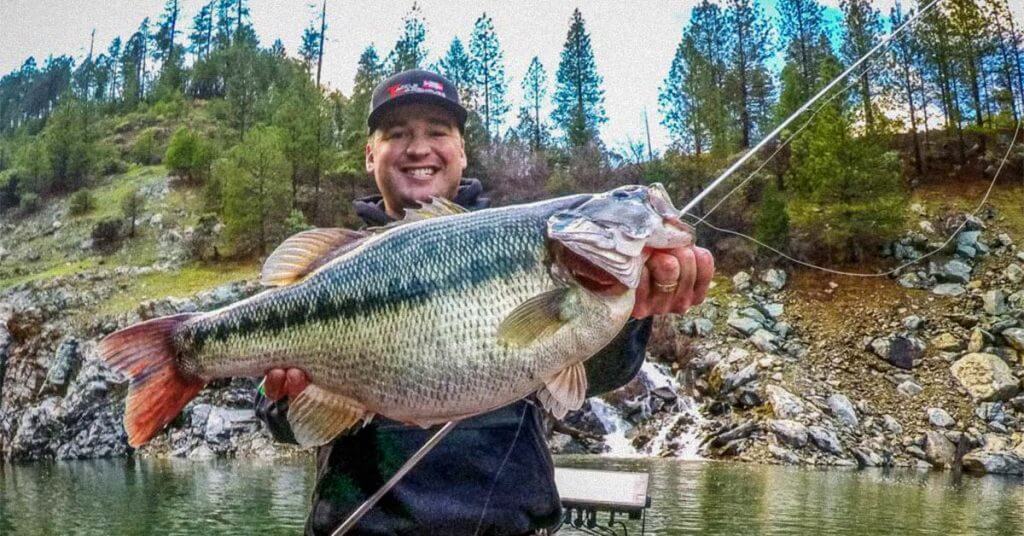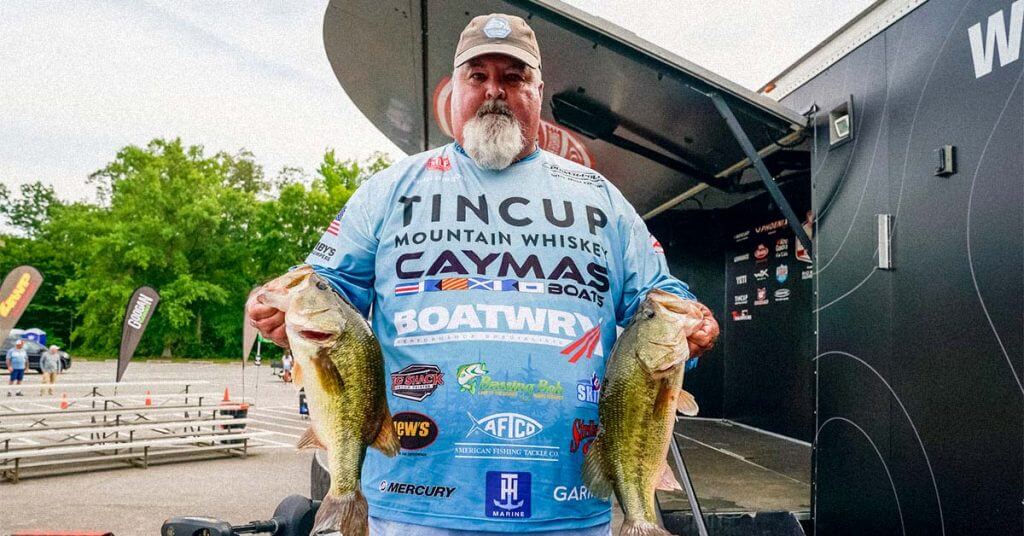It’s hard to teach an old dog new tricks. Especially when that dog is a highly respected national champion, but that description befits Rick Clunn, one of the greatest bass fishermen ever to compete.
Clunn is known for his rapid-fire casts to the shallows, his never-say-die attitude, and his ability to read the water and know where the bass will be.
But now 76 years of age, he is in the high-tech electronics era of bass fishing, where machines, not educated guesses, tell anglers where to cast.
Clunn admits it is a massive change for him. But he also knows that if he doesn’t adjust and learn some “new tricks,” he might be left behind.
“I come from a long line of old-style fishermen,” said Clunn, one of the only fishermen to win four Bassmaster Classics.
“Guys like Elroy Krueger, Tommy Martin, Kevin VanDam, and me, the way we were going to beat you was by making more casts than you.
We were going to cover more water than you.
“Now, some of these kids on tour don’t make a cast until they see fish on their electronics. It’s just a different game.”
Clunn still catches a lot of bass with his old-school methods. He became the oldest angler to win a national BASS Elite event when, at age 69, he took the title in a tournament on the St. Johns River in Florida in 2016.
Three years later, he broke his own record.
Now he is accepting the challenge of incorporating some new methods, such as using forward-facing sonar, which shows the real-time movement of fish, to add to his game plan.
“It’s hard to break old habits,” Clunn said. “But I am competing against younger anglers, and 80 percent of them are good with these electronics.
“I look at this as a challenge. It’s fascinating the things I am learning.”
Old school vs. new school. There are advantages to both, Clunn will tell you.
Hop into the boat, and he will show you.
Table of Contents
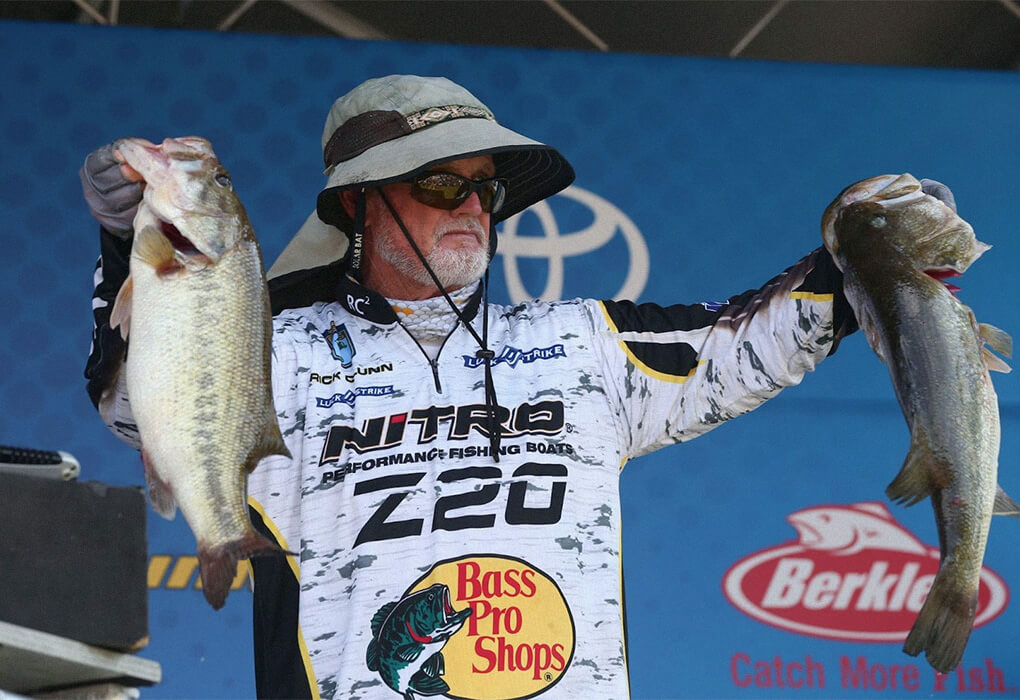
Even as a graybeard, Rick Clunn can fish with the best of them on the B.A.S.S. trail (photo by Gary Tramontina/B.A.S.S.)
Lots and Lots of Casts
Simple math tells a story about Clunn’s fishing style.
The Missouri pro always knew he was making a lot of casts to catch bass. But it wasn’t until a baseball statistician accompanied him in a tournament years ago did he know just how many.
That statistician accompanied Clunn during a B.A.S.S. tournament and spent the day jotting down notes.
When Clunn and his press observer headed from the lake to the weigh-in site, the Chicago resident announced his findings.
“He told me I made 2,348 casts that day,” Clunn said. “I made 7 ½ casts per minute in the morning, that it dropped off to 6 per minute in the afternoon, and that it was back to 7 at the end of the day,
“I hooked 25 bass and landed all but one of them. That’s a pretty lousy average of fish per cast.
“Yet, I had the heaviest bag for that day of fishing.”
That reinforced what Clunn had believed all along. Covering water with lots of casts can be the key to catching bass.
“None of my casts were very long,” Clunn said. “They were underhand casts to targets likely to hold bass.
“When I was good, I had a way of turning random casts into high-probability casts. I’d catch a fish off a treefall, then I’d catch another one in a similar situation, and pretty soon, I had a pattern.”
Clunn often used moving baits such as squarebill crankbaits or spinnerbaits so that he could work quickly. That way, he covered lots of water.
“Not every laydown, dock, or brush pile is going to hold bass,” he said. “But if I kept moving and had confidence in what I was using, I knew I would eventually find them.”
Though Clunn still endorses that fishing style, he can no longer launch that many casts per day. But the intuition he has gained over the years partially compensates for that.
“I’ve always prided myself in my awareness of what is going on in the natural world, figuring out where the bass and their forage should be,” he said.

Rick Clunn and the bass he catches often are in the spotlight in national tournaments (photo by B.A.S.S.)
Studying the Prey
Early in his career, Clunn learned a valuable lesson about bass from a person who had never fished.
Clunn attended a survival school and met an Apache Native American teaching animal tracking.
When he heard Clunn talking about bass fishing, he interjected, “You’re doing it backward. If I want to understand the owl, I do not study the owl. I study the mouse.
“You study the bass but not the food that controls where it will be.”
Clunn thought about that and agreed. Bass spend their lives dominated by two things: spawning and eating.
Learning about the forage and where it is located can go a long way toward determining where the bass will be.
The average-size bass will relate to shad and crawfish. But the true trophy fish will key on bream, crappies, and large shad, he believes.
“Bass over 6 pounds don’t want a bunch of small meals,” Clunn said. “They want a couple of big meals, and that’s enough to satisfy them.
“That’s why they’re not out there chasing down a bunch of small baitfish. They prefer to sit in cover and wait to ambush something larger.”
With that in mind, Clunn often uses a big Trickster spinnerbait or a large crankbait, such as a King Kong Shad, when he searches for a big bite.
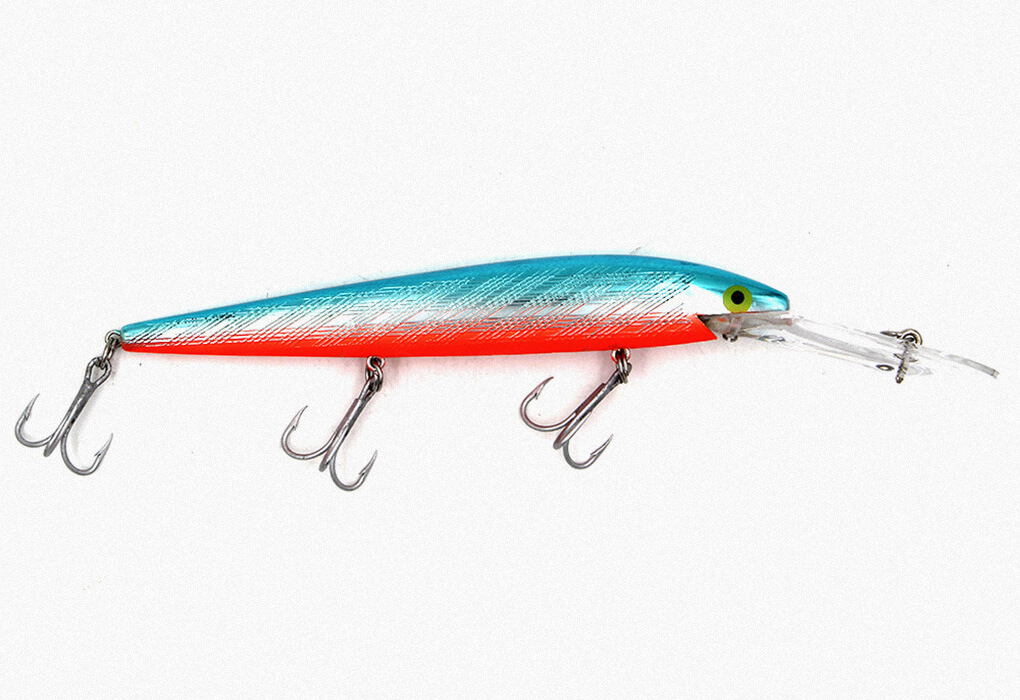
The Rebel Spoonbill Minnow
Old-School Bait that Still Works
Long before the modern suspending jerkbaits came along, savvy fishermen such as Clunn achieved the same effect with minnow baits.
One of Clunn’s favorite bait was an elongated Rebel Spoonbill Minnow.
He would cast it out, reel it down, then retrieve it with a sweeping motion. When he would pause, he would hold the lure at that depth with his rod and begin a countdown.
“One-thousand one, one-thousand two…I would usually get all the way to eight before the bass hit,” he said. “It was a great cold-water bait.
“I caught my first 32-pound stringer on that bait.”
The only problem: The bait didn’t have the transfer-weight system that modern jerkbaits have, and they were hard to cast accurately on windy days.
That’s why Clunn started incorporating flat-sided squarebill crankbaits that he designed into that system of sweeping the rod. They allowed for better casting accuracy and still could be paused by holding a bait in place.
The old-school minnow baits, such as the Rebel Spoonbill, have since been overshadowed by the modern jerkbaits that suspend and allow long casts.
But Clunn still uses the Rebel Spoonbills occasionally when conditions are favorable.
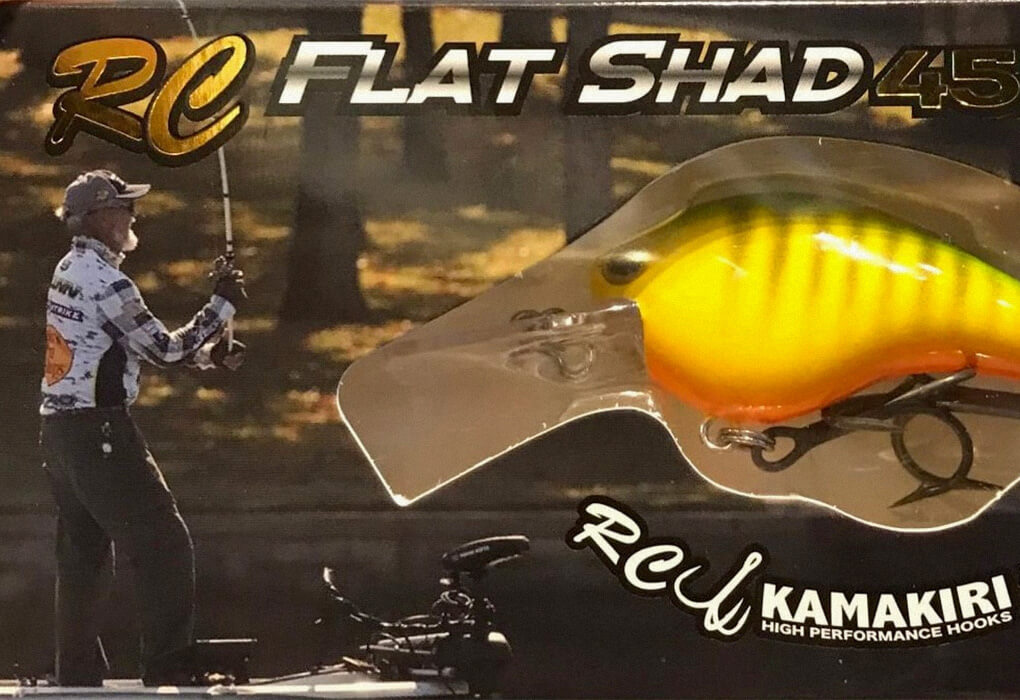
Rick Clunn often uses a small squarebill crankbait that he designed when the fishing gets tough
Clunn’s Secret Weapon
Clunn has made a name for himself, fishing big crankbaits in shallow cover.
But when the fishing gets tough, he goes down to a small flat-sided squarebill that he designed for Ichiwaka Lures, a Japanese company.
The Ichikawa Fishing RC Flat 45MD weighs only one-quarter of an ounce and runs about two feet deep. But Clunn labels it “my Save My Ass bait.”
“Nowadays, we are programmed to fish for big bass,” Clunn said. “But when the fishing gets very tough, I will go to a little bitty crankbait like this to find where the bass are located.”
“Then I’ll go back and throw something bigger to catch larger fish in that area.”
Some days, the tiny crankbait can produce big fish.
Clun remembers a practice day for an Elite tournament when he decided to use the RC Flat Shad 45 MD as a search bait, and he was surprised to catch a 6-pound largemouth on his first cast.
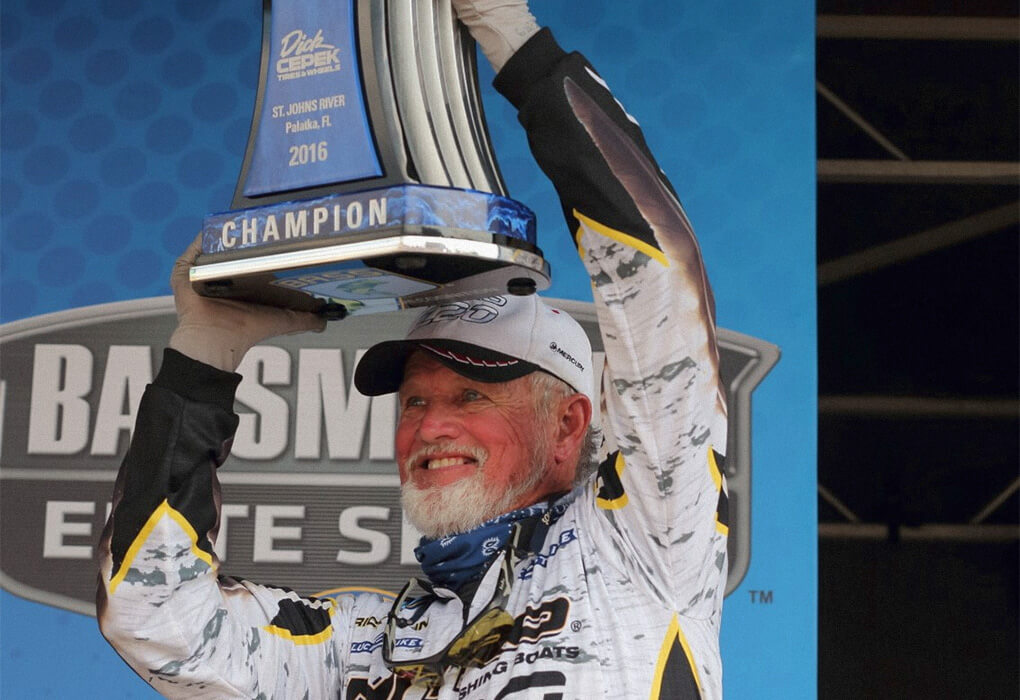
Rick Clunn has been on the B.A.S.S. tour for 46 years, but he still knows how to win (photo by B.A.S.S.)
New Ways
To compete on today’s pro circuit, Clunn knows he has to embrace new techniques.
That means leaving the banks where he is comfortable throwing crankbaits and spinnerbaits to shallow cover and heading off-shore to target main-lake bass.
“We are learning a lot about bass behavior through forward-facing sonar,” he said. “Eighty percent of what we thought we knew about big bass was incorrect.
“For example, they go deep but rarely relate to the bottom in clear reservoirs. Why? Because their prey, shad, seldom go to the bottom. All the microorganisms and plankton the baitfish feed on are up near the sunshine.”
Clunn also has learned that big bass seldom are found in schools. Instead, they might be loners or in small groups.
Even when those bass are suspended in deep water, stealth is required to catch them, Clunn said.
“I am already seeing how smart they are getting,” Clunn said. “Our boats make far more underwater noise than we ever thought. The engines, the trolling motors, the sonar signals…
“They hear that, and then they watch a couple of their buddies pulled out of there. Then the next day, it happens again. And I believe they learn to associate those sounds with danger, and they get harder to catch.”
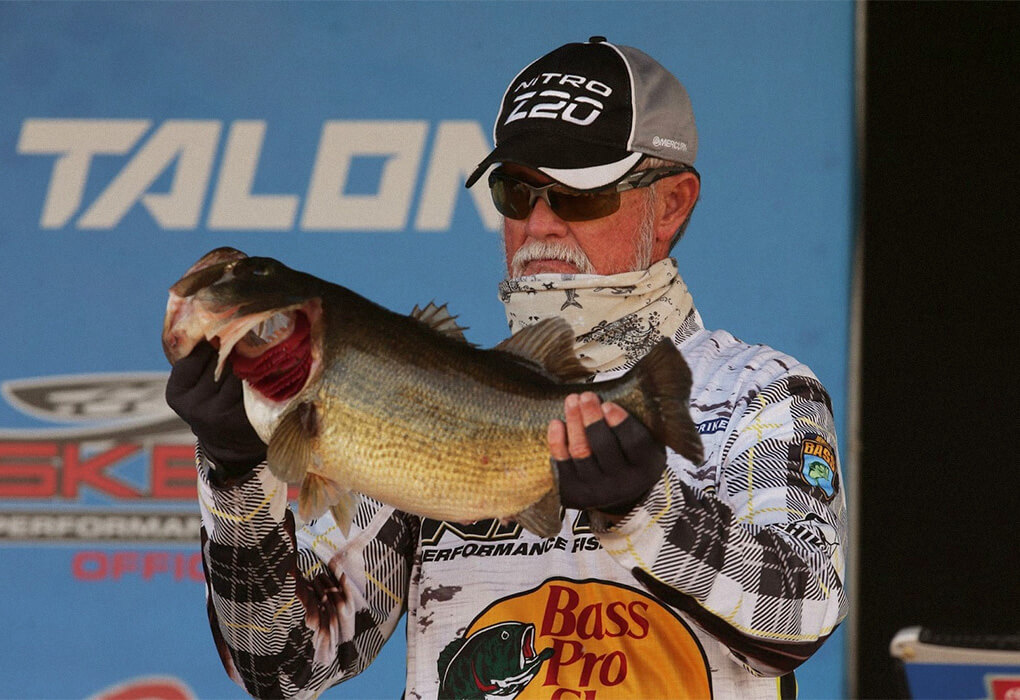
Rick Clunn is more than twice the age of some of his fellow fishermen on the B.A.S.S. Elite Tour, but he can still compete (Photo by B.A.S.S.)
Embracing Old Age
First, let’s get this clear. Don’t call Rick Clunn old. He would rather you refer to him as “experienced.”
He’s made it clear that he’s not ready for the rocking chair. Though he is still recovering from breaking his back in a tournament a couple of years ago when his boat hit a big wave, he says he is now at 80 percent.
And his passion for tournament fishing is at 100 percent.
That attitude has made him a cult hero for many senior citizens. When he became the oldest fisherman to win a B.A.S.S. Elite series tournament, he said, “Never accept that all of your best moments are behind you.”
That resulted in an amazing outpouring of support from senior citizens who view Clunn as a role model.
“I’ve always said that the great thing about fishing is that you can do it from ages 6 to 60 and older,” he said. “Getting older doesn’t relegate you to being an armchair quarterback.”
One thing it has done, though, it has forced Clunn to slow down. He is no longer making a couple thousand casts a day like he did when he was younger.
He now targets big fish by thoroughly dissecting a good-looking spot before moving on.
“Power poles were the best thing to ever happen to me,” he said, referring to the devices on bass boats that drop down and hold it in one place. “They forced me to stay in one area and analyze what was in front of me.
“Instead of fishing for the aggressive bass, I learned to search for the cover that would hold the biggest bass. They prefer the thickest cover they can find. They’re not chasers.
“You have to go where they live.”
For Clunn, that meant throwing big spinnerbaits, topwater lures, jigs, or oversized crankbaits to hard-to-reach spots.

Rick Clunn is at home casting to shallow cover (photo by B.A.S.S.)
Fishing Pressure
Clunn is convinced that fishing pressure has replaced the weather as the top variable in fishing.
“Back years ago, no one fished during the week,” he said. “Now there are times when there are as many boats on the lake mid-week as there are on weekends.
“And that has an effect. Bass get conditioned by seeing the same lures all the time.”
Clunn uses the buzzbait as an example.
“I caught a tremendous number of fish on a buzzbait years ago,” he said. “Now, it’s not nearly as effective.
“The Whopper Plopper, created by Larry Dahlberg is another example. It was the hottest lure around for a while. But once everyone started using it, it died down.”
The answer?
Try using something different.
For example, in a buddy tournament, the angler at the back of the boat should throw something different than the boater at the bow who gets all the choice targets.
Final Thoughts
So, what has Clunn taught us?
First, that old-school techniques still work, despite all the mania over forward-facing sonar.
Clunn advises taking nature’s clues. Pay attention to what fish are spitting up in the live well. Then try to match the length and color of what they are feeding on.
Beginners can thrive by studying the “mouse” – the primary prey they intend to fish in the lake.
Also, pay attention to what clues nature provides instead of keeping your face buried in a sonar unit screen.
Look for wind-blown banks, areas where gulls are diving down on shad, and out-of-the-way spawning pockets with gravel or rocky banks.
Look at water clarity and base the color selections of your lures accordingly. If the water is murky or muddy, go to more visible colors such as chartreuse or white. If it is clear, go to more natural colors.
Finally, don’t be afraid to experiment with something different than the crowd is casting on heavily pressured lakes.
Let us know what you think about Clunn’s advice in the comments section below.
That’s it for now. Think spring.

